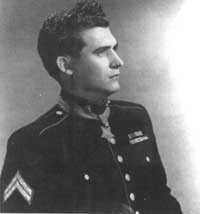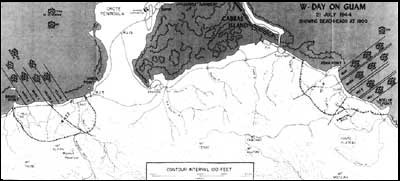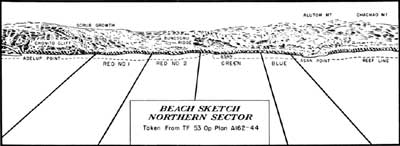| Marines in World War II Commemorative Series |
|
LIBERATION: Marines in the Recapture of Guam by Cyril J. O'Brien Ashore in the North Troops of the 3d Marine Division landed virtually in the lap of the Japanese island commander, General Takashina, whose U-shaped cave command post, carved out of a sandstone cliff, overlooked the Asan-Adelup beachhead. The looming heights dominated the beaches, particularly on the left and center, where the 3d and 21st Marines were headed for the shore. W-Day, 21 July 1944, opened as a beautiful day, but it soon turned hazy as the violent clouds of smoke, dust, and fire spiraled skyward. At 0808 an air observer shouted into his microphone: "First wave on the beach." At 0833, the same airborne announcer confirmed the battle was on, with: "Troops ashore on all beaches."
The 3d Marines under Colonel W. Carvel Hall struck on the far left of the 2,500-yard beachhead, the left flank of the division near Adelup Point. Ahead was Chonito Cliff, a ridge later named Bundschu Ridge, and high, difficult ground in back of which was the final beachhead line (FBHL), or first goal of the landing. The center, straight up the middle, belonged to the 21st Marines, under Colonel Arthur H. "Tex" Butler. The regiment would drive inland, secure a line of cliffs, and defend them until the division caught up and was ready to expand the beachhead outward. Under Colonel Edward A. Craig, the 9th Marines landed on the right flank near Asan Point, ready to strike in land over paddies to and across lower and more hospitable hills, but all part of the same formidable enemy-held ridgeline. The 3d Battalion, 9th Marines, under Lieutenant Colonel Walter Asmuth, Jr., caught intense fire from the front and right flank near Asan Point, and he had to call on tanks for assistance, but one company got to the ridge ahead quite rapidly and threw the defenders at Asan Point off balance, making the regiment's advance easier. (It would also be up to the 9th Marines to take Cabras, a little island offshore and hard against Apra Harbor. This would be accomplished with a separate amphibious landing.) With its 2d and 3d Battalions in the lead, the 9th Marines drove through its initial objectives quickly and had to slacken its advance in order not to thin out the divisions lines. Colonel Butler's 21st Marines, in a stroke of luck which would later be called unbelievable, found two unguarded defiles on either side of the regiment's zone of action. His troops climbed straight to the clifftops. No attempt was made to keep contact going up, but, on top, the 2d and 3d Battalions formed a bridge covering both defiles. The 1st Battalion swept the area below the cliffs. The 12th Marines (Colonel John B. Wilson) was quickly on the beach, with its burdensome guns and equipment, and the 3d Battalion of Lieutenant Colonel Alpha L. Bowser, Jr., was registered and firing by 1215. By 1640 every battery was in position and in support of the advance. Captain Austin P. Gattis of the 12th Marines attributed the success of his regiment in setting up quickly to "training, because we had done it over, and over, and over. It was efficiency learned and practiced and it always gave the 12th a leg up." On the far left, the 3d Marines was getting the worst of the enemy's increasing resistance. The regiment received intense mortar and artillery fire coming in and on the beaches, and faced the toughest terrain—steep cliffs whose approaches were laced with interlocking bands of Japanese machine gun fire. The cliffs were defended by foes who knew and used their weapons well. The Japanese, that close, would roll grenades right down the escarpment onto the Marines. Snipers could find protection and cover in the countless folds and ridges of the irregular terrain, and the ridgetops were arrayed like the breastworks of some nightmarish castle. It appeared that ten on top could hold off hundreds below.
One of the defenders, Lieutenant Kenichi Itoh, recalled that despite the terrible bombardment, he felt secure, that his countrymen could hold out for a long time, even win. After the war, recalling his feelings that eventful day in July 1944, the lieutenant considered it all a bad dream, "even absurd" to think that his forces could ever withstand the onslaught. On W-Day Lieutenant Colonel Ralph E. Houser's 3d Battalion, 3d Marines, was on the extreme left of the line, facing Adelup Point, which, with Asan Point, marked the right and left flanks of the invasion beaches. Houser's troops could seize the territory in his zone only with the support of tanks from Company C, 3d Tank Battalion, and half-track-mounted 75mm guns. Holding up the regimental advance was a little nose projecting from Chonito Ridge facing the invasion beach in the 1st Battalion, 3d Marines' zone. Early on W-Day (about 1045), Captain Geary R. Bundschu's Company A was able to secure a foothold within 100 yards of the crest of this promontory, but could not hold its positions in the face of intense enfilading machine gun fire. Captain Bundschu called for stretchers and corpsmen, then requested permission to disengage. Major Henry Aplington II, commanding the 1st Battalion, was "unwilling to give up ground in the tight area and told Captain Bundschu to hold what he had."
Colonel Hall ordered the attack to continue in mid-afternoon behind a massive 81mm mortar barrage. None of the companies of Major Aplington's battalion or Lieutenant Colonel Hector de Zayas' 2d Battalion could gain any ground beyond what they already precariously held. Their opponent, the 320th Independent Infantry Battalion held fast. A couple of hours later, Colonel Hall ordered another attack, with Companies A and E in the fore. Major Aplington recalled:
In the morning light of 22 July (W plus 1), that small but formidable Japanese position still held firmly against the 3d Marines' advance. During the bitter fighting of the previous day, Private First Class Luther Skaggs, Jr., of the 3d Battalion, led a mortar section through heavy enemy fire to support the attack, then defended his position against enemy counterattacks during the night although badly wounded. For conspicuous gallantry and bravery beyond the call of duty, he was awarded the Medal of Honor. On the 22d, Private First Class Leonard F. Mason, a Browning automatic rifleman of the 2d Battalion, earned a posthumous Medal of Honor for single-handedly attacking and wiping out an enemy machine gun position which threatened his unit. Although wounded severely, he rejoined his fellow Marines to continue the attack, but succumbed to his fatal wounds. During the day's bitter fighting, Colonel Hall tried to envelop the Japanese, using Companies A and C of Aplington's battalion and Company E of de Zayas'. On regimental orders, Aplington kicked it off at 1150. It also got nowhere at first. Company A got to the top but was thrown off. Company E was able to move ahead very slowly. Probe after probe, it found Japanese resistance perceptibly weakening. By 1900, the men of E reached the top, above Company A's position. The Japanese had pulled back. In the morning, a further advance confirmed the enemy withdrawal.
Medal of Honor Recipients 
Private First Class Luther Skaggs, Jr.'s Medal of Honor citation reads as follows: "For conspicuous gallantry and intrepidity at the risk of his life above and beyond the call of duty while serving as squad leader with a mortar section of a rifle company in the 3d Battalion, 3d Marines, 3d Marine Division, during action against enemy Japanese forces on the Asan-Adelup beachhead, Guam, Marianas Islands, 21-22 July 1944. When the section leader became a casualty under a heavy mortar barrage shortly after landing, Private First Class Skaggs promptly assumed command and led the section through intense fire for a distance of 200 yards to a position from which to deliver effective coverage of the assault on a strategic cliff. Valiantly defending this vital position against strong enemy counterattacks during the night, Private First Class Skaggs was critically wounded when a Japanese grenade lodged in his foxhole and exploded, shattering the lower part of one leg. Quick to act, he applied an improvised tourniquet and, while propped up in his foxhole, gallantly returned the enemy's fire with his rifle and hand grenades for a period of 8 hours, later crawling unassisted to the rear to continue the fight until the Japanese had been annihilated. Uncomplaining and calm throughout this critical period, Private First Class Skaggs served as a heroic example of courage and fortitude to other wounded men and, by his courageous leadership and inspiring devotion to duty, upheld the high traditions of the United States naval service." 
Private First Class Leonard Foster Mason's Medal of Honor citation reads as follows: "For conspicuous gallantry and intrepidity at the risk of his life above and beyond the call of duty as an automatic rifleman serving with the Second Battalion, Third Marines, Third Marine Division, in action against enemy Japanese forces on the Asan-Adelup Beachhead, Guam, Marianas Islands, on 22 July 1944. Suddenly taken under fire by two enemy machine guns not more than 15 yards away while clearing out hostile positions holding up the advance of his platoon through a narrow gully, Private First Class Mason, alone and entirely on his own initiative, climbed out of the gully and moved parallel to it toward the rear of the enemy position. Although fired upon immediately by hostile riflemen from a higher position and wounded repeatedly in the arm and shoulder, Private First Class Mason grimly pressed forward and had just reached his objective when hit again by a burst of enemy machine-gun fire, causing a critical wound to which he later succumbed. With valiant disregard for his own peril, he persevered, clearing out the hostile position, killing five Japanese, wounding another and then rejoining his platoon to report the results of his action before consenting to be evacuated. His exceptionally heroic act in the face of almost certain death enabled his platoon to accomplish its mission and reflects the highest credit upon Private First Class Mason and the United States naval service. He gallantly gave his life for his country."
|








